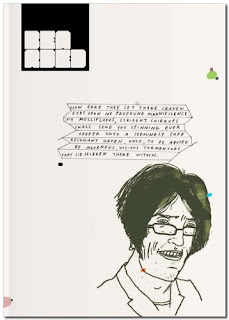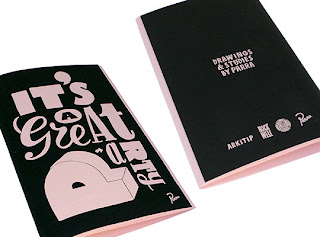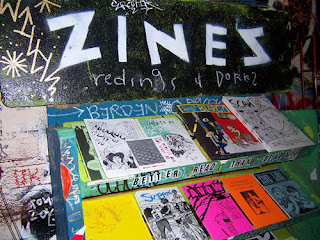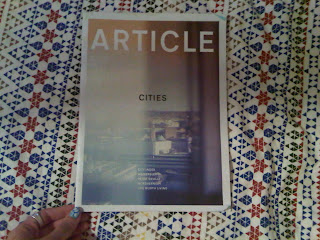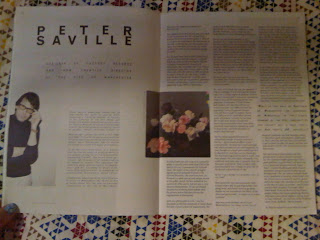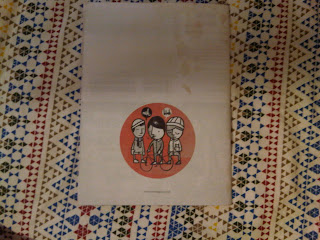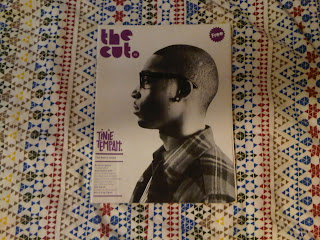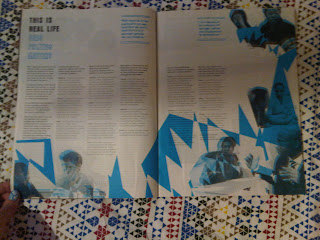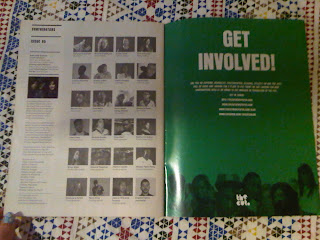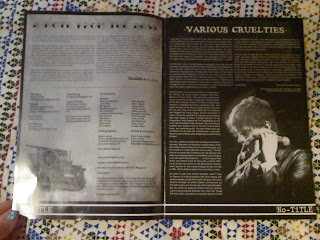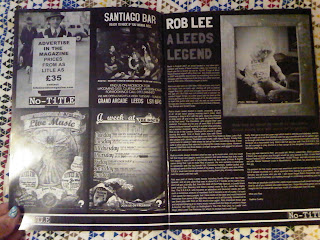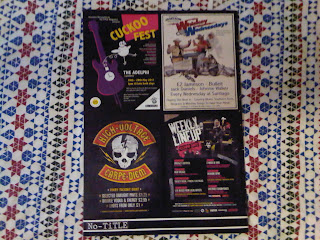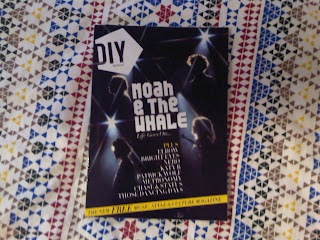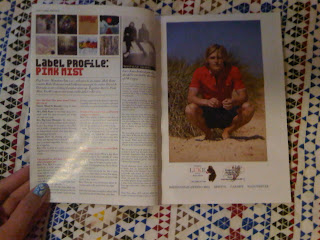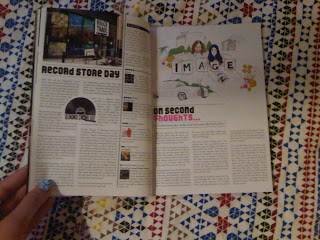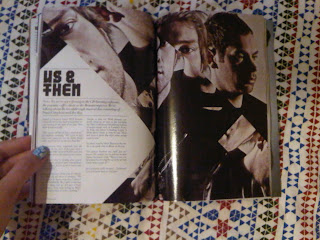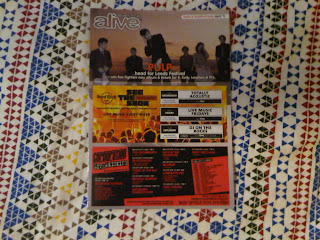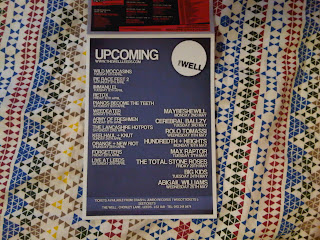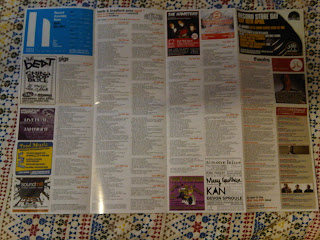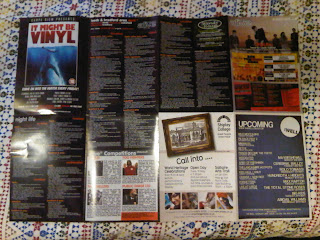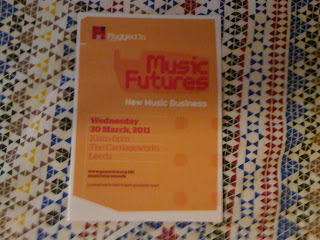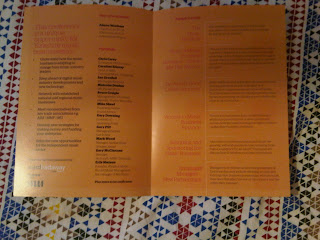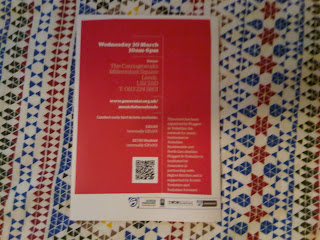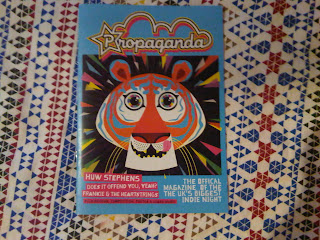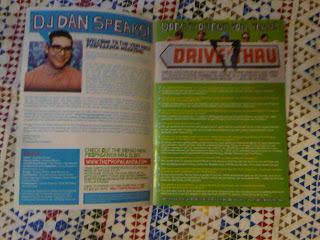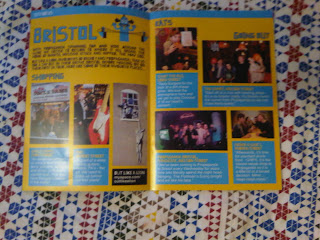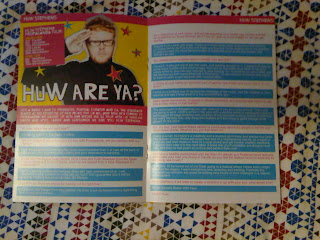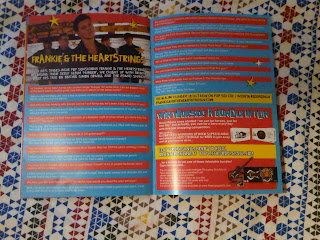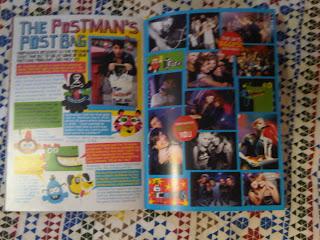Business plan discussed together as a group :
Thursday 28 April 2011
Slide 1,2 & Final - Me
Slide 1
Mission Statement :
Content :
‘Feedback Design’
Mission Statement :
"We design promotional and branding material for bands, record labels, gigs, events, recording studios
and solo artists. The drive of the company focuses around a collective passion for both design and music and ultimately the enthusiasm for a fusion of the two. "
and solo artists. The drive of the company focuses around a collective passion for both design and music and ultimately the enthusiasm for a fusion of the two. "
Script :
'Feedback Design' is a design company that specializes in promotion of the independent music industry in Leeds through well-considered design.
We understand that promotion, image and identity is integral to the success of any new band or night in Leeds; it is something that in most situations this target market won't have the budget to pay a designer £30 an hour - and that's where we come in.
Our company comprises of 4 creatives. It is a Limited Company on the basis that we want to share equal partnership in the company.
We will all cover the design areas of branding, promotional work and layout; as well as sharing responsibilities for accounts management, print liaison and networking.
We also take on individual roles in order to exploit our individual skills and share out the responsibilities equally :
• CHRIS – Typography, web and editorial
• MAT – Web, typography, photography, direct sales and marketing.
• MAT – Web, typography, photography, direct sales and marketing.
• PAV – Image making, illustration, idea generation.
• MYSELF – Image making, idea generation and print based media.
• MYSELF – Image making, idea generation and print based media.
Slide 2
Content :
"Business Objectives"
Zine to be distributed to record shops, appropriate clothing shops, gigs, venues, bars, clubs....
- Use 3rd year to create branding, website and business cards for our design company.
- Start standard design practice following graduation from 3rd year.
Full colour, printed magazine which offers advertising space as a way of funding
Script :
During our 3rd year we plan to run a cheaply made free zine that we would distribute throughout all the areas of the city associated with the music industry. This will enable to establish ourselves as an identity within the Leeds music scene and act as us free promotion and representaion of our design company prior to its launch. We will fund this through a small amount of advertising as well as exploiting the free facilities available to us at the Art College while we are in 3rd year.
This year will also provide us with the time to create all necessary design work for the company. We will use a small amount of collateral from our loans, for web hosting, business cards etc.
We plan to properly beguin our formal design practice following gradueation from 3rd year.
This year will also provide us with the time to create all necessary design work for the company. We will use a small amount of collateral from our loans, for web hosting, business cards etc.
We plan to properly beguin our formal design practice following gradueation from 3rd year.
Once comfortable profits are being made from our ongoing design practice, the zine will progress from
being free and cheaply made to a priced, decent quality full colour, printed magazine which offers
advertising space as a way of funding.
(images for slide 2) : also see separate post on business cards
advertising space as a way of funding.
(images for slide 2) : also see separate post on business cards
Final slide
Content :
"Future goals"
Following the intended success of our design company and magazine, we would aspire to use our network of clients and identity to develop a Leeds based record label.
Enterprise Meeting 28th March
My role - open and close presentation.
Elements to discuss :
1.The nature of the business
Business name
Business activity - What do you do?
Mission statement
Business objectives
· What are you plans to achieve your sales target in the first 12 months?
· What new products or services will you introduce in the following two years to grow your business?
· What is your long term / 5 year goal?
The people in the business
· How many people are employed?
· What are their roles?
What is the structure of your business?
· Describe the organisation – draw a diagram if appropriate
What is the legal status of your business?
· Is it Limited Company or partnership, social enterprise, cooperative or are you a sole trader?
· Why have you chosen this status – what are the advantages
Elements to discuss :
1.The nature of the business
Business name
Business activity - What do you do?
Mission statement
Business objectives
· What are you plans to achieve your sales target in the first 12 months?
· What new products or services will you introduce in the following two years to grow your business?
· What is your long term / 5 year goal?
The people in the business
· How many people are employed?
· What are their roles?
What is the structure of your business?
· Describe the organisation – draw a diagram if appropriate
What is the legal status of your business?
· Is it Limited Company or partnership, social enterprise, cooperative or are you a sole trader?
· Why have you chosen this status – what are the advantages
To be contained within opening slide, second slide and final slide.
Communication with 'DIY' Magazine
I e-mailed/telephoned a selection of zine's and free magazines to ask for their advertising cost card. We need to find out how much we can stand earn from advertising in order to work out how much we need to finance our magazine.
Rupert Vereker from DIY was the only one so far to respond - I rang him directly and he was happy to send me the media pack for the magazine.
Rupert Vereker from DIY was the only one so far to respond - I rang him directly and he was happy to send me the media pack for the magazine.
Wednesday 27 April 2011
Promotion - Recording studios
Selection of appropriate recoding studios and university facilities that would be suitable places for us to promote our business.
Networking - 'Plugged In Yorkshire'
Plugged In Yorkshire is an online network designed to support the Yorkshire music business. This is something that we could use for promotional and networking possibilities.
Zines - Research - 'article'
-low cost stock
-full colour in parts but 50% of the magazine is black/white + one spot colour to lower print costs
Information about creating, printing, running and distributing a Zine
Occult magazine publishing
by Phil Hine
There are at least 100 small press occult magazines in the UK, covering a wide variety of subjects from Asatru to Wicca. Some are aimed at a 'general' readership of pagans and magicians, whilst others are aimed at a specific audience. In this article, I'll be discussing some of the basic considerations for starting up a magazine, based on my experiences publishing three 'free' newsletters (Northern PaganLink News, KABAL newsletter and Rudraksha), Chaos International magazine, and Pagan News - a pagan/magical 'zine which, during the period 1988-1992 was either a monthly, bi-monthly or erratic publication, depending on time and resources.
Publishing an occult magazine can be great fun. It is also bloody hard work! To illustrate this, I've listed the basic elements as either 'Fun' or 'Tedious':
FUN
Creating the layout, and Typesetting
Designing covers & artwork
Writing articles & hassling other people to do the same
Reviewing books etc.
Gathering News
Enjoying 'Freebies' - tickets to events, review books from publishers, etc.
Reading 'hate mail' from readers you've offended
Networking with other people involved in small press publishing
Enjoying whatever 'kudos' might come from being a 'zine editor
running stalls at conferences
TEDIOUS
Managing advertising
Managing Subscriptions
Mailing out copies to subscribers & retailers
General Admin - Invoicing & chasing retailers for non-payment
Arranging distribution
Hand-carrying your entire print run back from the printers during a snow-storm!
Of course, the above is subjective. Personally, I enjoy doing magazine design and typesetting far more than sitting with a huge pile of envelopes parcelling up subscriber and retail copies then staggering to the post office with them.
ONE: STARTING OUT
Starting out with an Idea
A new magazine is often birthed on the basis that the editors have spotted a 'gap' in the current magazine market or that there is a 'target' audience for whom the 'zine would be beneficial. Of course, it also happens that some people start a 'zine to reflect their own ideas and that of their friends. For example, Northern PaganLink News (which eventually became Pagan News) was started by Rodney Orpheus and myself as we were at the time involved with PaganLink Network, and felt there should be a 'free' newsletter to keep people in the North of England up to date with networking events, meetings, etc. The success of the newsletter (in terms of both circulation and input), together with the realisation that there was at the time, no monthly pagan news-oriented 'zines which catered for a wide general readership in the UK, gave us the impetus to start up Pagan News - helped also by some people's stated opinion that this "couldn't be done!"
Getting Other People Involved
Doing a 'zine on your own is hard work, but at least you've only got yourself to blame when things go wrong or don't get done. Having a 'team' to help you is great if everyone is working together, but awful when things don't get done, as you end up arguing and then doing things yourself - which is a hassle, and in my experience, successful 'zine production requires keeping the hassles down to a minimum. For the first incarnation of Pagan News, we had 2 co-editors and two sub-editors - all of whom lived within walking distance of each other and had enough personal free time to work on the 'zine without getting distracted by other things. In my experience, if the editorial team is widely geographically distanced from each other, it's harder to meet on a regular basis and ensure that all the things which need doing are done well. This is particularly important if the 'zine is going to be issued frequently.
People are often all too willing to offer their aid to a zine project, but are equally often unrealistic about what they can do, given their other commitments and interests. As an editor, you need to know that when other people volunteer to take on a task, that:
they know what the task entails.
they have the resources to perform it (i.e. an advertising manager needs a telephone).
they have the ability to carry it out.
they can be relied upon to do it without you continually looking over their shoulder.
So if a friend offers to help out, don't turn them down, but do be careful lest you get into a situation which is going to lead to friction.
Pushing the Envelope
Any experienced 'zine editor will tell you that one of the hardest aspects of doing a 'zine is keeping up your own motivation and enthusiasm. If you're not 'high' on what you're doing, then the whole job becomes tedious and it's time to let the 'zine die a natural death or hand it on to someone else. So "Pushing the Envelope" is doing things related to the 'zine which keeps your enthusiasm and motivation up. In my experience, it's easier to start off on a high note and keep it going than otherwise.
The thing that set both Pagan News and Chaos International apart from the majority of other 'zines at the time was that we pushed the envelope not only on content but also production. Pagan News was one of the first UK small press Occult 'zines to use DTP (not counting the glossies, of course) and develop a coherent & consistent format. Nowadays of course most everyone has access to DTP and it's harder to make a 'zine look striking by DTP alone - Talking Stick and Towards 2012 are, I think, the best 2 UK 'zines from a design point of view. So another way to push the envelope is to try and do other things to make a 'zine stand out. Suggestions include:
Freebies
stickers - i.e. "Witches do it in a circle"
free music or computer CD-Rom
Spot Colour
Using colour on the cover will boost the cost. However, a single spot colour occasionally should not be too expensive. One could even consider doing the masthead in colour.
Promotional deals with shops
This involves striking a 'deal' with a book supplier so that there is a 'reader offer' of a discount from a particular outlet on selected books, etc. This can be used as a method to entice subscribers.
I have found that a good way to generate enthusiasm for a project is to get together with friends and throw ideas around - it doesn't really matter how wacky or improbable they are, so long as they get your enthusiasm up. When we were doing Pagan News, we used to have bi-monthly brainstorming meetings at a restaurant, which were great for injecting new ideas into the development of the 'zine.
Research & Content Planning
I have found that a useful way to gather ideas both for content and 'look 'n' feel' of a 'zine is look at other 'zines, both pagan & otherwise, for useful ideas. It's also useful, particularly if you haven't much experience with design, to look into what seem to be the most popular typefaces for body text, headers, etc., and the overall presentation styles of 'zines. By doing research, you can come up with a list of ideas for your 'zine's content. A sample Content listing might be:
Feature Articles
Interviews, Profiles on individuals or groups
Regular Columns
News/gossip
Events listing (free for non profit-making events)
Occult web news
Reviews - books, events, music, games, etc.
Reader's Letters
Humour/Fiction
Graphics & if possible, a cartoon feature.
Exchange mags listing
Display & Classified Ads
Once you have some idea of what your 'zine's contents will be, you are in a better position to work out how you are going to obtain that content, and how it can be arranged in the 'zine.
How big is the 'zine going to be?
There are two considerations here - the size of the pages (for example, A4 or A5) and the page count. Taking size first - an A5 'zine for example will obviously be smaller than an A4 size 'zine, but might not stand out so well when placed on a magazine rack in a shop. If you're mainly going to distribute your 'zine to subscribers, this might not matter so much. An A5 'zine composed of folded A4 sheets might well be cheaper to produce than an A4 'zine (using A3 folded sheets). When you are considering size (and page count) it's a good idea to ring around a few local printers and get some quotes. When we started Pagan News, the printers we used (Agit-Press in Leeds) could do A4 printing, but not A3, so the first incarnation of the size was A4 but side-stitched -not an ideal way to do a 'zine (as we did all the stapling ourselves!) but it kept the production costs down.
The other consideration is the number of pages. I think it helps here if you have some idea about how frequently you're going to issue the 'zine. Pagan News started off as 8 pages - which was fine for a 'zine which was going to be released every three weeks or so, and we gradually upped the page count as the 'zine developed. Unless you've got access to major resources, I'd think it would be difficult in the extreme to do a 48-page 'zine like Chaos International on a monthly basis, as the more pages you have, the more content you have to find. I feel it's better to start out small and gradually increase the page size, rather than start out huge and then find you have to drop the page count because you can't fill the magazine.
Covers
Here you need to think about what kind of cover the zine will have - paper, art paper, card, glossy paper, etc. Obviously the heavier the cover, the more expensive it will be to produce the 'zine, and the added weight might also affect postage (particularly bulk postage).
Print Runs
When considering how many copies you're going to produce, you need to have some idea of how many copies you're going to shift, particularly for the first issue. There's no point printing 1000 copies of a 'zine if you're going to be stuck with hundreds of copies you can't get rid of and if you're doing a 'zine from home, storage space might well be an issue to consider. Again some research will pay off here - contacting possible retail outlets and asking them if they are interested in stocking your 'zine and how many copies they are prepared to take. Finding out if there are any local pagan or occult discussion forums where you might be able to sell a few copies. In my experience, telephoning people or visiting them directly brings in better feedback than setting out letters.
TWO: WHAT'S INVOLVED
Before getting to the creative aspects of 'zine production, I'll briefly go through all the aspects of administration you need to consider.
Getting an Address
Unless you're happy with all correspondence coming to your home address, you need to think about getting some kind of separate address for your 'zine. Two popular methods in the UK are Post Office boxes and the British Monomarks service. Getting a Post Office box can have problems. There are two services - one for letters and the other for letters and parcels. However the main problem I find with the post office is that you can only get a P.O. Box within your local area. This is fine if you can get to it readily, but if for example, you work in a different area, it's going to be difficult to check your box regularly. The alternative is British Monomarks - a forwarding service where you are either assigned a box number or can choose your own name, and mail which is sent to it can either be picked up directly or forwarded to you at an extra charge. So many UK occult 'zines use British Monomarks that there are conspiracy theories flying around about the service! Another plus for having a separate address for your 'zine is that you don't get people calling round to see you at all hours of the day and night!
Where does the money go?
Unless you're very good at managing money, it's usually a good idea to set up a separate account for the 'zine.
General Administration
If you're going to be dealing with subscribers, (also advertisers, retailers, etc.) then you'll need some way of keeping track of them. Having a computer will help here - and databases, invoicing systems etc. but card indexes can be used and they have the advantage of still being accessible if your computer crashes. Writing address labels by hand is extremely tedious, so bear in mind that most printers can produce sheets of labels to order. You may also want to think about stationery too - letterheads, flyers, compliments slips, delivery notes, etc.
To and from the Printers
When you're looking for printers, it's useful if you can find a firm which is local to where you live or work, so that you can get hard copy to them with the minimum of hassle.
All the 'zines that I have been involved in producing were run out from laser printer hard copy. This is fine for most general purposes, but complex internal artwork (particularly colour photographs and the like) might require running out onto film or alternatively, sending to a printer as a postscript file. If you think you're going be doing this sort of thing, speak to your printers about their file preparation requirements.
Whilst some printers will deliver jobs to you, some might require you to pick them up personally. So having access to a car might be something to think about. It's not a problem if you're only doing a relatively small 'zine, but hand-carrying large boxes of magazines on public transport can be a nightmare - on one memorable occasion I collected 700 copies of my own 'zine and 500 copies of a friend's 'zine and lugged them from Sheffield to Leeds on public transport through a snowstorm that severely disrupted train and bus services!
Setup Costs
Starting a 'zine costs money. How much money, of course, depends on what you want to do and how you go about it. In addition to the actual cost of printing the 'zine, there's going to be postage costs, envelopes, telephone calls, stationery, labels, plus any bits of computer gear you might need. This all adds up, so it's as well to be aware of it. Whilst it's not impossible to get a 'zine running so that it pays for itself, it's difficult (at least I found it difficult) to get into a situation where you're making a decent profit on it. For most people, doing a pagan/occult 'zine is is largely a labour of love.
Advertising
If you're going to have adverts in your 'zine you need to think about what your rates for space are, and maybe doing a 'rates card' showing sizes, design styles, and costs. Again, some research is worthwhile - visiting local shops and calling up any friends who run businesses and talking them into taking out some advertising. This can be difficult, particularly with the first issue - but not impossible. The first issue of the free KABAL newsletter (advertising talks for a University discussion forum) was entirely paid for by selling advertising space). It can be useful to give some businesses 'freebies' in the first issue. As a lot of pagan 'zines come and go after only a couple of issues, businesses are often wary of taking out advertising. A 'sales pitch' I've used with some success when talking retailers into taking both advert space and copies of a 'zine is to say that all stockists will be listed in the 'zine, and that when punters come into the shop to see if the latest issue is in stock, they might well buy something else if it isn't. In Pagan News we occasionally ran 'advertorials' where retailers who regularly took advertising space were given a column write up and a photo of the shop.
Adverts are basically either line space (costing so much per line), boxed adverts - line text + a box, or display adverts. If your 'zine is fairly small, you might have to think about how much space you can reasonably devote to adverts without pissing your readers off.
Exchange Adverts
The exchange advert scheme is basically - you advertise my 'zine in yours and I'll mention your 'zine in mine. This can be useful for building contacts and goodwill between 'zine editors and, if need be, filling space. When we started Pagan News, we had limited space (8 A4 pages!) and quite an aggressive advertising policy (no freebies!) so we didn't start doing exchange ads until much later. What does tend to happen is that some 'zine editors will list your 'zine without asking and then expect you to do the same for them - and then get offended if you don't.
Keeping Going
Once you start offering subscriptions, you're in a situation of promising people that you'll be around until their subscription runs out. If you're starting a 'zine with no prior experience it can be difficult to assess how much hassle it's going to be, so it's worth thinking about making your subscriptions reflect this - or even not offering subscriptions until after the first couple of issues. Although it's sometimes unavoidable, letting down people who've paid for subscriptions in advance is not a situation you want to get into.
THREE: HOT METAL
Laying Out the 'zine
Whether you opt for using glue, scissors & letraset, budget DTP on a home computer or using a local graphics bureau, you need to think about how you're going to lay out the 'zine. Rather than launching into a discussion of DTP skills here, I'm going to try and discuss some of the design considerations related to putting 'zines together.
If a 'zine doesn't look appealing, people aren't likely to buy it. I've seen quite a few pagan & magical 'zines which are nothing more than a few badly photocopied pages stapled together. Unless the content is amazing, people are unlikely to feel that they've got their money's worth.
What goes on the Cover?
There's quite a few things to think about here. Obviously there's the title of your 'zine, and possibly the issue number or date of release. Do you put the price on? If you don't, then some retailers will put their own price tag on the 'zine. This can be counter-productive, as the editor of Towards 2012 found when one of the Virgin chain stores marked up his recommended price by 350%! You need to consider how you want the cover to change across issues. Chaos International, for example, used a standard cover layout for every issue but with a different issue number and cover artwork. Other 'zines use the same cover artwork but vary the colour of the cover paper. As Pagan News was very much a news-oriented 'zine, we used the front page in a similar manner to the tabloid press - a boxed masthead with the issue date and price next to it, with news headlines below. As the 'zine developed into more of magazine style, this was eventually replaced with cover artwork and by-lines advertising the main features. Talking Stick took yet another approach - changing the colour of the 'zine's binding and using a small full-colour postcard affixed to the cover. Whatever you do, be consistent in your approach.
Consistency in laying out the 'zine
This is very much a matter of taste. Some 'zine editors change each issue's layout radically so that each issue looks different from the last one. Personally, I prefer to establish a 'zine style so that, where possible, regular features have common elements of design across issues and appear in more or less the same section of the 'zine. Here's a sample design layout from Pagan News:
Front page - masthead, price & issue details, lead stories
Page 2 - news stories continued
Page 3 - news (left-hand column) & Events listing (right-hand column)
Page 4 - Viewpoint (reader's soapbox)
Page 5 - Viewpoint continuation, plus 1 column of display advertising
Page 6 - Reviews
Page 7 - Regular Column
Page 8 - Regular Feature
Page 9 - Regular Feature
Page 10 - Humour/Cartoon
Page 11- Reader's Letters
Page 12 - Left-hand column: Editorial, address & subscription rates; right-hand column: Classified Adverts & details of next issue
Maintaining a consistent layout helps make the 'zine easier to read, particularly if readers' have a 'favourite' feature or column that they tend to read first. Another advantage to this approach is that it helps you plan your content so that you can get some idea of what you need for each upcoming issue. Again, this will depend on the frequency of publication. For Pagan News, at any one time we had an issue being sold, the next issue under construction, and the issue to follow that being planned, and found that some feature slots were filled three or four months in advance of publication.
Getting Input for the 'zine
Input consists of:
articles, columns, etc.
artwork
items for review (books, cds, mags, videos, software, etc.)
Written Material
An ideal to be aimed for when starting a new 'zine is to have enough material for the first two issues. This needn't necessarily be a tight plan for the first two issues - but it's better in general, to have to much material rather than not enough. To go about this, get together a shortlist of anyone who you think you can badger into writing for your 'zine. Having an Internet connection can be helpful here, so that you can find material on the World-Wide Web and email the authors regarding permission to print.
Another possible source is 'old' material which has gone out of copyright.
However you go about it, it's a good idea to be kind to your contributors. If someone sends in a submission, at least try and reply (letter, email or even a compliments slip) - authors (myself included) tend to interpret silence from 'zine editors as a refusal or lack of interest - and therefore send submissions elsewhere. This can end up in a situation where two 'zines come out at the same time, both featuring the same article! This tends to be annoying for 'zine editors, but it usually means that someone has forgotten to keep an author posted on whether they're going to use his or her submission. Remember, an informed contributor is a happy contributor - and happy contributors may even send you more material in the future. The same goes for informing authors about editorial cuts - though there's not always time to do this.
Creating a Style Sheet
Having a Style Sheet to send out to prospective contributors can be helpful here. A Style Sheet details what kind of submissions you are looking for, in terms of subject, content, number of words, and what kind of format you would prefer to receive material in. Some 'zines for example, request that contributors send in their work on disk in particular file formats, and also as hard copy. You can develop your Style Sheet over time, as you get a clearer idea of what kind of input you require for the 'zine. This will be to some extent dictated by the format of the 'zine. For example, Chaos International at 48 pages plus per issue could easily cope with long essays of 2000 words plus, and, since it was aimed at a 'hardcore' magical readership, then in-depth treatments of various occult subjects were suitable. In contrast, Pagan News, as a short, news-oriented 'zine with a wide general readership required short, punchy articles, sometimes with a maximum length of 700 words! Again, it helps to have planned the kind of features you're looking for, so you can begin to look for suitable contributors for them.
Regular Features
Having regular features are useful for several reasons. For a start, it's helpful when you're planning the 'zine if you know that on page 10 there'll be 'x' feature and you can arrange the content well in advance. Also, if the feature is popular with readers then they are quite likely to buy the 'zine just for reading that feature. Here's some of the regular features which appeared in Pagan News:
Viewpoint - reader's soapbox
Things to Do ... And Things to Read - a short, single column featuring a look at a particular magical technique, with a suggested reading list appended.
Letter from ... - a feature which began as a series of 'letters' from an American correspondent and expanded into perspectives on the local occult scene from correspondents all over the world.
SkyWatcher - A regular astrology feature, eventually superseded by Astrology with Attitude.
She Speaks - A Women's Mysteries column
Crafty Talk - a column shared by two different Wiccan writers
Third Eye - science/general weirdness column
Spotlight - Interview feature
Listings
Again listings can be very useful. Pagan News consistently featured a 'Meetings' listing of pagan moots, gatherings, & regular events. This listing was for 'free' events only. Large meetings such as conferences were either featured as 'news' or adverts. Another type of Listing, which ran as a half-column for several issues, was Sacred Days - a listing of 'holy days' from different pagan cultures.
Artwork & Graphics
Sources for finding artwork include:
Finding people who will do original artwork for you
Using existing artwork
Computer clip art
Once again, if you've thought about what kind of artwork you need for the 'zine in advance, it's much easier to go looking for it. If you've looked at a selection of existing 'zines, then you can make contact with their editors and ask them if they will put you in contact with artists whose style you like. Like other contributors, it's useful to draw up a shortlist of possible artists to contact. Again, the size and format of your 'zine will dictate how much artwork you will need. In a large 'zine like Chaos International, it's not unusual to have three or four pages of full-page artwork. For a smaller 'zine, you might only require graphics for feature headers and the occasional cartoon. If you have time between issues, you might consider sending out articles to artists so that they can come up with suitable illustrations.
Computer Clip-Art
There's a hell of a lot of computer clip-art out there, and equally, a lot of it is awful. One of the best clip-art sets I have come across recently is the IMSI Master Clips collection, which includes the Dover Pictorial Archive series - a massive collection of borders, art deco illustrations, historical and mythological themes, etc. Clip art should be used sparingly, and in my view, works best at small sizes.
Stuff to Review
If you want to feature reviews in your 'zine, you need to decide what kind of reviews are appropriate - i.e. are you going to review anything and everything or only reviews which relate to the theme of your 'zine. As I said earlier, doing reviews is one of the fringe benefits of doing a 'zine.
Finding stuff to review can be difficult for a first issue. Most publishing companies will want to see a copy of the 'zine beforehand (and it is generally polite to send them a copy of the issue in which their publication etc. is reviewed).
The approach we developed for reviews for Pagan News was to work up a Reviews Style Sheet and send books etc. out to people who already had an interest in that particular genre, with the understanding that they got to keep the book!
by Phil Hine
There are at least 100 small press occult magazines in the UK, covering a wide variety of subjects from Asatru to Wicca. Some are aimed at a 'general' readership of pagans and magicians, whilst others are aimed at a specific audience. In this article, I'll be discussing some of the basic considerations for starting up a magazine, based on my experiences publishing three 'free' newsletters (Northern PaganLink News, KABAL newsletter and Rudraksha), Chaos International magazine, and Pagan News - a pagan/magical 'zine which, during the period 1988-1992 was either a monthly, bi-monthly or erratic publication, depending on time and resources.
Publishing an occult magazine can be great fun. It is also bloody hard work! To illustrate this, I've listed the basic elements as either 'Fun' or 'Tedious':
FUN
Creating the layout, and Typesetting
Designing covers & artwork
Writing articles & hassling other people to do the same
Reviewing books etc.
Gathering News
Enjoying 'Freebies' - tickets to events, review books from publishers, etc.
Reading 'hate mail' from readers you've offended
Networking with other people involved in small press publishing
Enjoying whatever 'kudos' might come from being a 'zine editor
running stalls at conferences
TEDIOUS
Managing advertising
Managing Subscriptions
Mailing out copies to subscribers & retailers
General Admin - Invoicing & chasing retailers for non-payment
Arranging distribution
Hand-carrying your entire print run back from the printers during a snow-storm!
Of course, the above is subjective. Personally, I enjoy doing magazine design and typesetting far more than sitting with a huge pile of envelopes parcelling up subscriber and retail copies then staggering to the post office with them.
ONE: STARTING OUT
Starting out with an Idea
A new magazine is often birthed on the basis that the editors have spotted a 'gap' in the current magazine market or that there is a 'target' audience for whom the 'zine would be beneficial. Of course, it also happens that some people start a 'zine to reflect their own ideas and that of their friends. For example, Northern PaganLink News (which eventually became Pagan News) was started by Rodney Orpheus and myself as we were at the time involved with PaganLink Network, and felt there should be a 'free' newsletter to keep people in the North of England up to date with networking events, meetings, etc. The success of the newsletter (in terms of both circulation and input), together with the realisation that there was at the time, no monthly pagan news-oriented 'zines which catered for a wide general readership in the UK, gave us the impetus to start up Pagan News - helped also by some people's stated opinion that this "couldn't be done!"
Getting Other People Involved
Doing a 'zine on your own is hard work, but at least you've only got yourself to blame when things go wrong or don't get done. Having a 'team' to help you is great if everyone is working together, but awful when things don't get done, as you end up arguing and then doing things yourself - which is a hassle, and in my experience, successful 'zine production requires keeping the hassles down to a minimum. For the first incarnation of Pagan News, we had 2 co-editors and two sub-editors - all of whom lived within walking distance of each other and had enough personal free time to work on the 'zine without getting distracted by other things. In my experience, if the editorial team is widely geographically distanced from each other, it's harder to meet on a regular basis and ensure that all the things which need doing are done well. This is particularly important if the 'zine is going to be issued frequently.
People are often all too willing to offer their aid to a zine project, but are equally often unrealistic about what they can do, given their other commitments and interests. As an editor, you need to know that when other people volunteer to take on a task, that:
they know what the task entails.
they have the resources to perform it (i.e. an advertising manager needs a telephone).
they have the ability to carry it out.
they can be relied upon to do it without you continually looking over their shoulder.
So if a friend offers to help out, don't turn them down, but do be careful lest you get into a situation which is going to lead to friction.
Pushing the Envelope
Any experienced 'zine editor will tell you that one of the hardest aspects of doing a 'zine is keeping up your own motivation and enthusiasm. If you're not 'high' on what you're doing, then the whole job becomes tedious and it's time to let the 'zine die a natural death or hand it on to someone else. So "Pushing the Envelope" is doing things related to the 'zine which keeps your enthusiasm and motivation up. In my experience, it's easier to start off on a high note and keep it going than otherwise.
The thing that set both Pagan News and Chaos International apart from the majority of other 'zines at the time was that we pushed the envelope not only on content but also production. Pagan News was one of the first UK small press Occult 'zines to use DTP (not counting the glossies, of course) and develop a coherent & consistent format. Nowadays of course most everyone has access to DTP and it's harder to make a 'zine look striking by DTP alone - Talking Stick and Towards 2012 are, I think, the best 2 UK 'zines from a design point of view. So another way to push the envelope is to try and do other things to make a 'zine stand out. Suggestions include:
Freebies
stickers - i.e. "Witches do it in a circle"
free music or computer CD-Rom
Spot Colour
Using colour on the cover will boost the cost. However, a single spot colour occasionally should not be too expensive. One could even consider doing the masthead in colour.
Promotional deals with shops
This involves striking a 'deal' with a book supplier so that there is a 'reader offer' of a discount from a particular outlet on selected books, etc. This can be used as a method to entice subscribers.
I have found that a good way to generate enthusiasm for a project is to get together with friends and throw ideas around - it doesn't really matter how wacky or improbable they are, so long as they get your enthusiasm up. When we were doing Pagan News, we used to have bi-monthly brainstorming meetings at a restaurant, which were great for injecting new ideas into the development of the 'zine.
Research & Content Planning
I have found that a useful way to gather ideas both for content and 'look 'n' feel' of a 'zine is look at other 'zines, both pagan & otherwise, for useful ideas. It's also useful, particularly if you haven't much experience with design, to look into what seem to be the most popular typefaces for body text, headers, etc., and the overall presentation styles of 'zines. By doing research, you can come up with a list of ideas for your 'zine's content. A sample Content listing might be:
Feature Articles
Interviews, Profiles on individuals or groups
Regular Columns
News/gossip
Events listing (free for non profit-making events)
Occult web news
Reviews - books, events, music, games, etc.
Reader's Letters
Humour/Fiction
Graphics & if possible, a cartoon feature.
Exchange mags listing
Display & Classified Ads
Once you have some idea of what your 'zine's contents will be, you are in a better position to work out how you are going to obtain that content, and how it can be arranged in the 'zine.
How big is the 'zine going to be?
There are two considerations here - the size of the pages (for example, A4 or A5) and the page count. Taking size first - an A5 'zine for example will obviously be smaller than an A4 size 'zine, but might not stand out so well when placed on a magazine rack in a shop. If you're mainly going to distribute your 'zine to subscribers, this might not matter so much. An A5 'zine composed of folded A4 sheets might well be cheaper to produce than an A4 'zine (using A3 folded sheets). When you are considering size (and page count) it's a good idea to ring around a few local printers and get some quotes. When we started Pagan News, the printers we used (Agit-Press in Leeds) could do A4 printing, but not A3, so the first incarnation of the size was A4 but side-stitched -not an ideal way to do a 'zine (as we did all the stapling ourselves!) but it kept the production costs down.
The other consideration is the number of pages. I think it helps here if you have some idea about how frequently you're going to issue the 'zine. Pagan News started off as 8 pages - which was fine for a 'zine which was going to be released every three weeks or so, and we gradually upped the page count as the 'zine developed. Unless you've got access to major resources, I'd think it would be difficult in the extreme to do a 48-page 'zine like Chaos International on a monthly basis, as the more pages you have, the more content you have to find. I feel it's better to start out small and gradually increase the page size, rather than start out huge and then find you have to drop the page count because you can't fill the magazine.
Covers
Here you need to think about what kind of cover the zine will have - paper, art paper, card, glossy paper, etc. Obviously the heavier the cover, the more expensive it will be to produce the 'zine, and the added weight might also affect postage (particularly bulk postage).
Print Runs
When considering how many copies you're going to produce, you need to have some idea of how many copies you're going to shift, particularly for the first issue. There's no point printing 1000 copies of a 'zine if you're going to be stuck with hundreds of copies you can't get rid of and if you're doing a 'zine from home, storage space might well be an issue to consider. Again some research will pay off here - contacting possible retail outlets and asking them if they are interested in stocking your 'zine and how many copies they are prepared to take. Finding out if there are any local pagan or occult discussion forums where you might be able to sell a few copies. In my experience, telephoning people or visiting them directly brings in better feedback than setting out letters.
TWO: WHAT'S INVOLVED
Before getting to the creative aspects of 'zine production, I'll briefly go through all the aspects of administration you need to consider.
Getting an Address
Unless you're happy with all correspondence coming to your home address, you need to think about getting some kind of separate address for your 'zine. Two popular methods in the UK are Post Office boxes and the British Monomarks service. Getting a Post Office box can have problems. There are two services - one for letters and the other for letters and parcels. However the main problem I find with the post office is that you can only get a P.O. Box within your local area. This is fine if you can get to it readily, but if for example, you work in a different area, it's going to be difficult to check your box regularly. The alternative is British Monomarks - a forwarding service where you are either assigned a box number or can choose your own name, and mail which is sent to it can either be picked up directly or forwarded to you at an extra charge. So many UK occult 'zines use British Monomarks that there are conspiracy theories flying around about the service! Another plus for having a separate address for your 'zine is that you don't get people calling round to see you at all hours of the day and night!
Where does the money go?
Unless you're very good at managing money, it's usually a good idea to set up a separate account for the 'zine.
General Administration
If you're going to be dealing with subscribers, (also advertisers, retailers, etc.) then you'll need some way of keeping track of them. Having a computer will help here - and databases, invoicing systems etc. but card indexes can be used and they have the advantage of still being accessible if your computer crashes. Writing address labels by hand is extremely tedious, so bear in mind that most printers can produce sheets of labels to order. You may also want to think about stationery too - letterheads, flyers, compliments slips, delivery notes, etc.
To and from the Printers
When you're looking for printers, it's useful if you can find a firm which is local to where you live or work, so that you can get hard copy to them with the minimum of hassle.
All the 'zines that I have been involved in producing were run out from laser printer hard copy. This is fine for most general purposes, but complex internal artwork (particularly colour photographs and the like) might require running out onto film or alternatively, sending to a printer as a postscript file. If you think you're going be doing this sort of thing, speak to your printers about their file preparation requirements.
Whilst some printers will deliver jobs to you, some might require you to pick them up personally. So having access to a car might be something to think about. It's not a problem if you're only doing a relatively small 'zine, but hand-carrying large boxes of magazines on public transport can be a nightmare - on one memorable occasion I collected 700 copies of my own 'zine and 500 copies of a friend's 'zine and lugged them from Sheffield to Leeds on public transport through a snowstorm that severely disrupted train and bus services!
Setup Costs
Starting a 'zine costs money. How much money, of course, depends on what you want to do and how you go about it. In addition to the actual cost of printing the 'zine, there's going to be postage costs, envelopes, telephone calls, stationery, labels, plus any bits of computer gear you might need. This all adds up, so it's as well to be aware of it. Whilst it's not impossible to get a 'zine running so that it pays for itself, it's difficult (at least I found it difficult) to get into a situation where you're making a decent profit on it. For most people, doing a pagan/occult 'zine is is largely a labour of love.
Advertising
If you're going to have adverts in your 'zine you need to think about what your rates for space are, and maybe doing a 'rates card' showing sizes, design styles, and costs. Again, some research is worthwhile - visiting local shops and calling up any friends who run businesses and talking them into taking out some advertising. This can be difficult, particularly with the first issue - but not impossible. The first issue of the free KABAL newsletter (advertising talks for a University discussion forum) was entirely paid for by selling advertising space). It can be useful to give some businesses 'freebies' in the first issue. As a lot of pagan 'zines come and go after only a couple of issues, businesses are often wary of taking out advertising. A 'sales pitch' I've used with some success when talking retailers into taking both advert space and copies of a 'zine is to say that all stockists will be listed in the 'zine, and that when punters come into the shop to see if the latest issue is in stock, they might well buy something else if it isn't. In Pagan News we occasionally ran 'advertorials' where retailers who regularly took advertising space were given a column write up and a photo of the shop.
Adverts are basically either line space (costing so much per line), boxed adverts - line text + a box, or display adverts. If your 'zine is fairly small, you might have to think about how much space you can reasonably devote to adverts without pissing your readers off.
Exchange Adverts
The exchange advert scheme is basically - you advertise my 'zine in yours and I'll mention your 'zine in mine. This can be useful for building contacts and goodwill between 'zine editors and, if need be, filling space. When we started Pagan News, we had limited space (8 A4 pages!) and quite an aggressive advertising policy (no freebies!) so we didn't start doing exchange ads until much later. What does tend to happen is that some 'zine editors will list your 'zine without asking and then expect you to do the same for them - and then get offended if you don't.
Keeping Going
Once you start offering subscriptions, you're in a situation of promising people that you'll be around until their subscription runs out. If you're starting a 'zine with no prior experience it can be difficult to assess how much hassle it's going to be, so it's worth thinking about making your subscriptions reflect this - or even not offering subscriptions until after the first couple of issues. Although it's sometimes unavoidable, letting down people who've paid for subscriptions in advance is not a situation you want to get into.
THREE: HOT METAL
Laying Out the 'zine
Whether you opt for using glue, scissors & letraset, budget DTP on a home computer or using a local graphics bureau, you need to think about how you're going to lay out the 'zine. Rather than launching into a discussion of DTP skills here, I'm going to try and discuss some of the design considerations related to putting 'zines together.
If a 'zine doesn't look appealing, people aren't likely to buy it. I've seen quite a few pagan & magical 'zines which are nothing more than a few badly photocopied pages stapled together. Unless the content is amazing, people are unlikely to feel that they've got their money's worth.
What goes on the Cover?
There's quite a few things to think about here. Obviously there's the title of your 'zine, and possibly the issue number or date of release. Do you put the price on? If you don't, then some retailers will put their own price tag on the 'zine. This can be counter-productive, as the editor of Towards 2012 found when one of the Virgin chain stores marked up his recommended price by 350%! You need to consider how you want the cover to change across issues. Chaos International, for example, used a standard cover layout for every issue but with a different issue number and cover artwork. Other 'zines use the same cover artwork but vary the colour of the cover paper. As Pagan News was very much a news-oriented 'zine, we used the front page in a similar manner to the tabloid press - a boxed masthead with the issue date and price next to it, with news headlines below. As the 'zine developed into more of magazine style, this was eventually replaced with cover artwork and by-lines advertising the main features. Talking Stick took yet another approach - changing the colour of the 'zine's binding and using a small full-colour postcard affixed to the cover. Whatever you do, be consistent in your approach.
Consistency in laying out the 'zine
This is very much a matter of taste. Some 'zine editors change each issue's layout radically so that each issue looks different from the last one. Personally, I prefer to establish a 'zine style so that, where possible, regular features have common elements of design across issues and appear in more or less the same section of the 'zine. Here's a sample design layout from Pagan News:
Front page - masthead, price & issue details, lead stories
Page 2 - news stories continued
Page 3 - news (left-hand column) & Events listing (right-hand column)
Page 4 - Viewpoint (reader's soapbox)
Page 5 - Viewpoint continuation, plus 1 column of display advertising
Page 6 - Reviews
Page 7 - Regular Column
Page 8 - Regular Feature
Page 9 - Regular Feature
Page 10 - Humour/Cartoon
Page 11- Reader's Letters
Page 12 - Left-hand column: Editorial, address & subscription rates; right-hand column: Classified Adverts & details of next issue
Maintaining a consistent layout helps make the 'zine easier to read, particularly if readers' have a 'favourite' feature or column that they tend to read first. Another advantage to this approach is that it helps you plan your content so that you can get some idea of what you need for each upcoming issue. Again, this will depend on the frequency of publication. For Pagan News, at any one time we had an issue being sold, the next issue under construction, and the issue to follow that being planned, and found that some feature slots were filled three or four months in advance of publication.
Getting Input for the 'zine
Input consists of:
articles, columns, etc.
artwork
items for review (books, cds, mags, videos, software, etc.)
Written Material
An ideal to be aimed for when starting a new 'zine is to have enough material for the first two issues. This needn't necessarily be a tight plan for the first two issues - but it's better in general, to have to much material rather than not enough. To go about this, get together a shortlist of anyone who you think you can badger into writing for your 'zine. Having an Internet connection can be helpful here, so that you can find material on the World-Wide Web and email the authors regarding permission to print.
Another possible source is 'old' material which has gone out of copyright.
However you go about it, it's a good idea to be kind to your contributors. If someone sends in a submission, at least try and reply (letter, email or even a compliments slip) - authors (myself included) tend to interpret silence from 'zine editors as a refusal or lack of interest - and therefore send submissions elsewhere. This can end up in a situation where two 'zines come out at the same time, both featuring the same article! This tends to be annoying for 'zine editors, but it usually means that someone has forgotten to keep an author posted on whether they're going to use his or her submission. Remember, an informed contributor is a happy contributor - and happy contributors may even send you more material in the future. The same goes for informing authors about editorial cuts - though there's not always time to do this.
Creating a Style Sheet
Having a Style Sheet to send out to prospective contributors can be helpful here. A Style Sheet details what kind of submissions you are looking for, in terms of subject, content, number of words, and what kind of format you would prefer to receive material in. Some 'zines for example, request that contributors send in their work on disk in particular file formats, and also as hard copy. You can develop your Style Sheet over time, as you get a clearer idea of what kind of input you require for the 'zine. This will be to some extent dictated by the format of the 'zine. For example, Chaos International at 48 pages plus per issue could easily cope with long essays of 2000 words plus, and, since it was aimed at a 'hardcore' magical readership, then in-depth treatments of various occult subjects were suitable. In contrast, Pagan News, as a short, news-oriented 'zine with a wide general readership required short, punchy articles, sometimes with a maximum length of 700 words! Again, it helps to have planned the kind of features you're looking for, so you can begin to look for suitable contributors for them.
Regular Features
Having regular features are useful for several reasons. For a start, it's helpful when you're planning the 'zine if you know that on page 10 there'll be 'x' feature and you can arrange the content well in advance. Also, if the feature is popular with readers then they are quite likely to buy the 'zine just for reading that feature. Here's some of the regular features which appeared in Pagan News:
Viewpoint - reader's soapbox
Things to Do ... And Things to Read - a short, single column featuring a look at a particular magical technique, with a suggested reading list appended.
Letter from ... - a feature which began as a series of 'letters' from an American correspondent and expanded into perspectives on the local occult scene from correspondents all over the world.
SkyWatcher - A regular astrology feature, eventually superseded by Astrology with Attitude.
She Speaks - A Women's Mysteries column
Crafty Talk - a column shared by two different Wiccan writers
Third Eye - science/general weirdness column
Spotlight - Interview feature
Listings
Again listings can be very useful. Pagan News consistently featured a 'Meetings' listing of pagan moots, gatherings, & regular events. This listing was for 'free' events only. Large meetings such as conferences were either featured as 'news' or adverts. Another type of Listing, which ran as a half-column for several issues, was Sacred Days - a listing of 'holy days' from different pagan cultures.
Artwork & Graphics
Sources for finding artwork include:
Finding people who will do original artwork for you
Using existing artwork
Computer clip art
Once again, if you've thought about what kind of artwork you need for the 'zine in advance, it's much easier to go looking for it. If you've looked at a selection of existing 'zines, then you can make contact with their editors and ask them if they will put you in contact with artists whose style you like. Like other contributors, it's useful to draw up a shortlist of possible artists to contact. Again, the size and format of your 'zine will dictate how much artwork you will need. In a large 'zine like Chaos International, it's not unusual to have three or four pages of full-page artwork. For a smaller 'zine, you might only require graphics for feature headers and the occasional cartoon. If you have time between issues, you might consider sending out articles to artists so that they can come up with suitable illustrations.
Computer Clip-Art
There's a hell of a lot of computer clip-art out there, and equally, a lot of it is awful. One of the best clip-art sets I have come across recently is the IMSI Master Clips collection, which includes the Dover Pictorial Archive series - a massive collection of borders, art deco illustrations, historical and mythological themes, etc. Clip art should be used sparingly, and in my view, works best at small sizes.
Stuff to Review
If you want to feature reviews in your 'zine, you need to decide what kind of reviews are appropriate - i.e. are you going to review anything and everything or only reviews which relate to the theme of your 'zine. As I said earlier, doing reviews is one of the fringe benefits of doing a 'zine.
Finding stuff to review can be difficult for a first issue. Most publishing companies will want to see a copy of the 'zine beforehand (and it is generally polite to send them a copy of the issue in which their publication etc. is reviewed).
The approach we developed for reviews for Pagan News was to work up a Reviews Style Sheet and send books etc. out to people who already had an interest in that particular genre, with the understanding that they got to keep the book!
Networking - 'Music Futures' - Event
'Music Futures' is a conference in Leeds and an oppertunity for the Yorkshire music businesses to come together. This is exactly the kind of thing we need to be getting involved with in order to get ourselves out there. It costs £20 for a ticket or £17.50 for a student concession. This is something we should consider budgeting for as part of our networking.
Subscribe to:
Posts (Atom)


